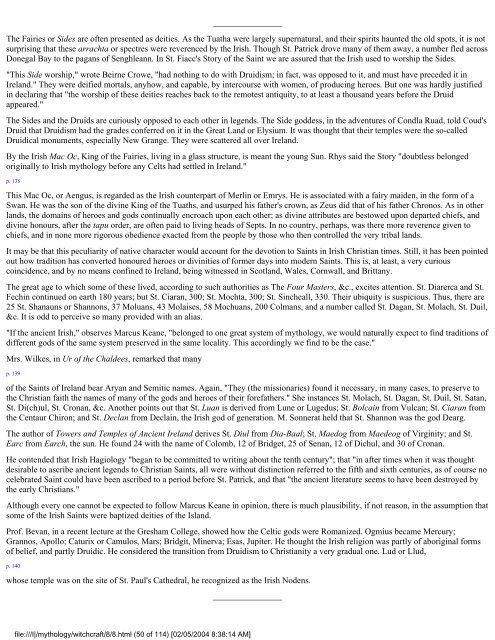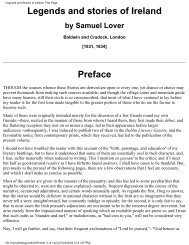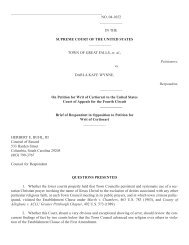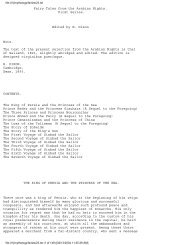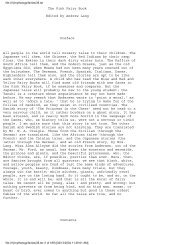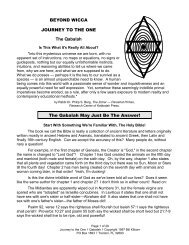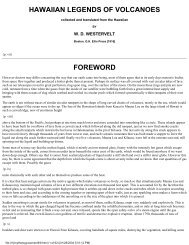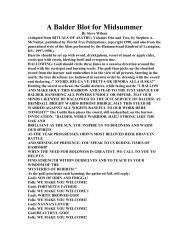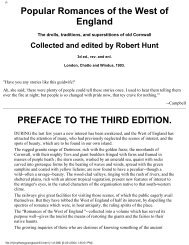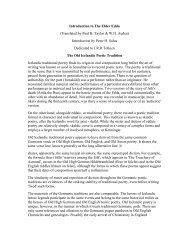Irish Druids And Old Irish Religions PREFACE CONTENTS
Irish Druids And Old Irish Religions PREFACE CONTENTS
Irish Druids And Old Irish Religions PREFACE CONTENTS
You also want an ePaper? Increase the reach of your titles
YUMPU automatically turns print PDFs into web optimized ePapers that Google loves.
________________<br />
The Fairies or Sides are often presented as deities. As the Tuatha were largely supernatural, and their spirits haunted the old spots, it is not<br />
surprising that these arrachta or spectres were reverenced by the <strong>Irish</strong>. Though St. Patrick drove many of them away, a number fled across<br />
Donegal Bay to the pagans of Senghleann. In St. Fiacc's Story of the Saint we are assured that the <strong>Irish</strong> used to worship the Sides.<br />
"This Side worship," wrote Beirne Crowe, "had nothing to do with Druidism; in fact, was opposed to it, and must have preceded it in<br />
Ireland." They were deified mortals, anyhow, and capable, by intercourse with women, of producing heroes. But one was hardly justified<br />
in declaring that "the worship of these deities reaches back to the remotest antiquity, to at least a thousand years before the Druid<br />
appeared."<br />
The Sides and the <strong>Druids</strong> are curiously opposed to each other in legends. The Side goddess, in the adventures of Condla Ruad, told Coud's<br />
Druid that Druidism had the grades conferred on it in the Great Land or Elysium. It was thought that their temples were the so-called<br />
Druidical monuments, especially New Grange. They were scattered all over Ireland.<br />
By the <strong>Irish</strong> Mac Oc, King of the Fairies, living in a glass structure, is meant the young Sun. Rhys said the Story "doubtless belonged<br />
originally to <strong>Irish</strong> mythology before any Celts had settled in Ireland."<br />
p. 138<br />
This Mac Oc, or Aengus, is regarded as the <strong>Irish</strong> counterpart of Merlin or Emrys. He is associated with a fairy maiden, in the form of a<br />
Swan. He was the son of the divine King of the Tuaths, and usurped his father's crown, as Zeus did that of his father Chronos. As in other<br />
lands, the domains of heroes and gods continually encroach upon each other; as divine attributes are bestowed upon departed chiefs, and<br />
divine honours, after the tapu order, are often paid to living heads of Septs. In no country, perhaps, was there more reverence given to<br />
chiefs, and in none more rigorous obedience exacted from the people by those who then controlled the very tribal lands.<br />
It may be that this peculiarity of native character would account for the devotion to Saints in <strong>Irish</strong> Christian times. Still, it has been pointed<br />
out how tradition has converted honoured heroes or divinities of former days into modern Saints. This is, at least, a very curious<br />
coincidence, and by no means confined to Ireland, being witnessed in Scotland, Wales, Cornwall, and Brittany.<br />
The great age to which some of these lived, according to such authorities as The Four Masters, &c., excites attention. St. Diarerca and St.<br />
Fechin continued on earth 180 years; but St. Ciaran, 300; St. Mochta, 300; St. Sincheall, 330. Their ubiquity is suspicious. Thus, there are<br />
25 St. Shanauns or Shannons, 37 Moluans, 43 Molaises, 58 Mochuans, 200 Colmans, and a number called St. Dagan, St. Molach, St. Duil,<br />
&c. It is odd to perceive so many provided with an alias.<br />
"If the ancient <strong>Irish</strong>," observes Marcus Keane, "belonged to one great system of mythology, we would naturally expect to find traditions of<br />
different gods of the same system preserved in the same locality. This accordingly we find to be the case."<br />
Mrs. Wilkes, in Ur of the Chaldees, remarked that many<br />
p. 139<br />
of the Saints of Ireland bear Aryan and Semitic names. Again, "They (the missionaries) found it necessary, in many cases, to preserve to<br />
the Christian faith the names of many of the gods and heroes of their forefathers." She instances St. Molach, St. Dagan, St. Duil, St. Satan,<br />
St. Di(ch)ul, St. Cronan, &c. Another points out that St. Luan is derived from Lune or Lugedus; St. Bolcain from Vulcan; St. Ciaran from<br />
the Centaur Chiron; and St. Declan from Declain, the <strong>Irish</strong> god of generation. M. Sonnerat held that St. Shannon was the god Dearg.<br />
The author of Towers and Temples of Ancient Ireland derives St. Diul from Dia-Baal; St. Maedog from Maedeog of Virginity; and St.<br />
Earc from Earch, the sun. He found 24 with the name of Colomb, 12 of Bridget, 25 of Senan, 12 of Dichul, and 30 of Cronan.<br />
He contended that <strong>Irish</strong> Hagiology "began to be committed to writing about the tenth century"; that "in after times when it was thought<br />
desirable to ascribe ancient legends to Christian Saints, all were without distinction referred to the fifth and sixth centuries, as of course no<br />
celebrated Saint could have been ascribed to a period before St. Patrick, and that "the ancient literature seems to have been destroyed by<br />
the early Christians."<br />
Although every one cannot be expected to follow Marcus Keane in opinion, there is much plausibility, if not reason, in the assumption that<br />
some of the <strong>Irish</strong> Saints were baptized deities of the Island.<br />
Prof. Bevan, in a recent lecture at the Gresham College, showed how the Celtic gods were Romanized. Ogmius became Mercury;<br />
Grannos, Apollo; Caturix or Camulos, Mars; Bridgit, Minerva; Esas, Jupiter. He thought the <strong>Irish</strong> religion was partly of aboriginal forms<br />
of belief, and partly Druidic. He considered the transition from Druidism to Christianity a very gradual one. Lud or Llud,<br />
p. 140<br />
whose temple was on the site of St. Paul's Cathedral, he recognized as the <strong>Irish</strong> Nodens.<br />
________________<br />
file:///I|/mythology/witchcraft/8/8.html (50 of 114) [02/05/2004 8:38:14 AM]


